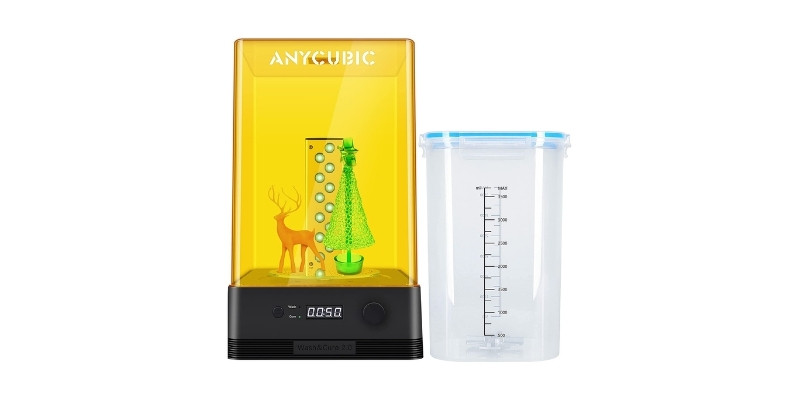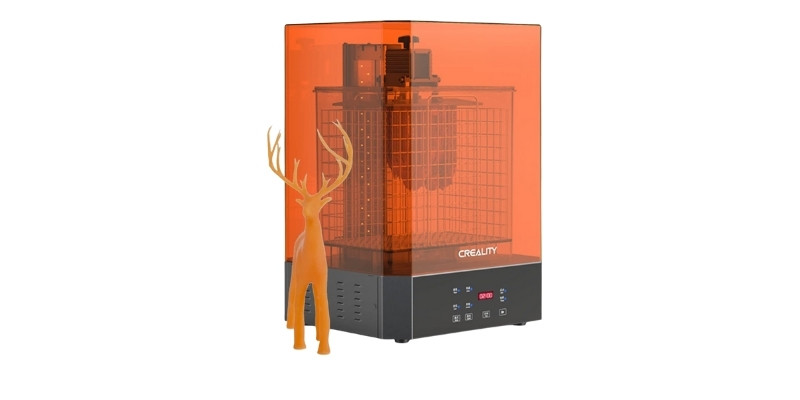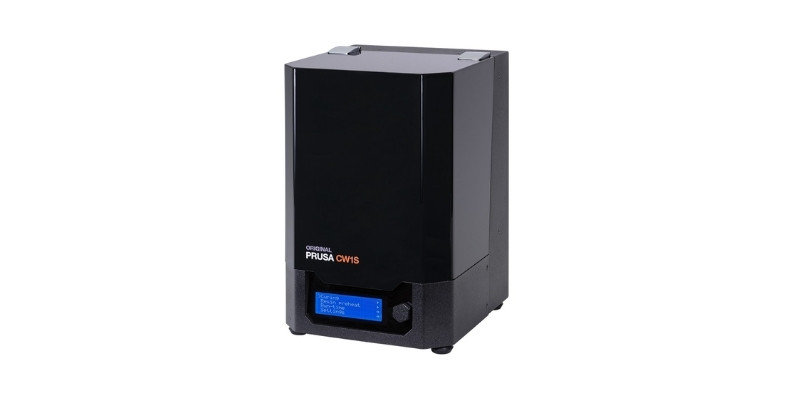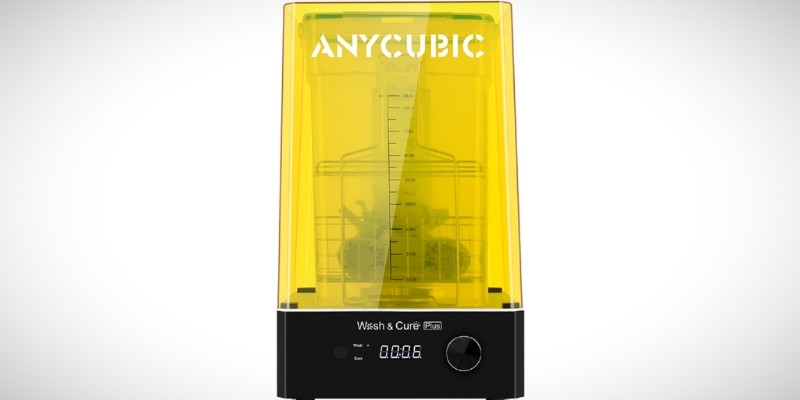
Washing and curing is an unavoidable aspect of resin 3D printing. It’s a messy business. But the best wash and cure stations take charge of every part of post-processing your resin prints to get them spick and span.
No more dangerous isopropanol dipping — these marvels keep things clean, efficient and save you time in the process.
For this guide, we’ve washed, cured, rinsed, and repeated to highlight the best wash and cure stations currently available. Though more resin printers are on the market than ever, the choice of stations is still relatively thin. Even so, we’ll help you sort the duds from the worthy buys.
What is a Resin Curing Station?
A resin 3D printing curing station, sometimes known as a UV curing station, is a standalone resin printing accessory designed to cure a finished resin print.
It does this by emitting a specific UV wavelength that helps the resin set and solidify. Without curing, resin remains malleable and prone to scratches and other blemishes.
You’ll often find a resin curing station bundled alongside a washing station in a 2-in-1 machine, commonly referred to as a wash and cure station.
The washing function removes any excess, uncured resin from the print, a task usually performed using isopropanol and necessary to ensure the curing process only hardens the printed resin.
Advantages of a Wash and Cure Station
- Cleaner and less messy than manual washing and curing
- Faster than manual washing and curing
- Consistent and smooth resin prints
- Provides even and uniform curing across the full surface of a model
- Set-and-forget post-processing
- Adjustable washing and curing cycles.

Do You Need a Wash and Cure Station for Resin 3D Printing?
Strictly speaking, no, you don’t need a wash and cure machine for resin 3D printing. You can do the same as a station yourself – first dunking the prints in isopropanol to clean them, then curing them with any standard lamp or even out in the sun.
But, as with most accessories, wash and cure stations offer a convenient and time-saving solution to the most common complaint levied at resin printers: they are messy. A resin wash and cure station makes the whole post-printing process easier, quicker, and cleaner.
They come in self-contained designs to avoid spillages and contact with hazardous isopropanol. And, on the curing front, they offer timed curing to ensure the resin gets just the right amount of exposure and just the right dialed UV wavelength so that it sets properly.
Best Wash and Cure Stations
Anycubic Wash & Cure 2.0 and Plus
- Price: Check latest price at Anycubic here / Amazon here
- Wash Volume: 120 x 74 x 165 mm/192 x 120 x 290 mm
- Cure Volume: 140 x 165 mm/190 x 245 mm

Pros
Ideal for Anycubic resin printers like the Photon M3 and Photon Mono ranges.
Expandable volume: upgrade to the Plus if you plan on printing large resin prints.
Very simple to set up and use.
Cons
Expensive: it’s great if you have the budget, but if you’re trying to save, there are other options that are almost as good.
Anycubic’s duo of wash and cure stations are all about simplicity. They are no-fuss machines that get the job done with very reasonable price tags.
First, the Anycubic Wash & Cure 2.0 is priced at $149 (though with the company’s love for a good sale, it’s often down to as low as $109). It features a wash and a cure mode.
The wash cycle takes place in a provided resealed plastic bin and included dipping basket to avoid spills and contact with toxic resin/isopropanol. The container has a 120 x 74 x 165 mm wash volume and 140 x 165 mm cure volume, plenty for most small to medium-sized resin prints, meaning the machine is limited by print size and not the print itself. That said, thanks to a build plate mount, resin prints can be washed as they come off Anycubic resin printers.
The cure cycle is powered by a 12 LED array pumping out 405 nm UV light. The shroud comes with a UV-blocking coating to ward off 99.95% of UV light. You can set the cure time up to 60 minutes for complete control over the process, and the machine comes. It also has a 360° rotating turntable. Additionally, and this is where it sets itself apart from competitor models from the likes of Creality and Elegoo, it has a reflective stickered base to ensure uniform distribution of UV light across the print’s entire surface.
Over to the $250 (often down to as low as $199) Anycubic Wash & Cure Plus. It takes the 2.0 and supersizes the washing volume to 192 x 120 x 290 mm and curing capacity to 190 x 245 mm, allowing you to process much larger resin prints.
Elsewhere, the Anycubic Wash & Cure Plus extends the array to 20 LEDs, including an adjustable L-shaped extension to cure the top of prints consistently. Otherwise, it borrows many of the same features as the 2.0, including the turntable, reflective bottom, 405nm UV wavelength, cycle timing options, and UV-blocking shroud.
Elegoo Mercury Plus 2.0 and Mercury X
- Price: Check latest price at Elegoo here / Check price on Amazon here
- Wash Volume: 131 x 90 x 220 mm/201 x 124 x 255 mm
- Cure Volume: 140 x 165 mm/200 x 260 mm

Very similar in both style and function to Anycubic’s 3D print cure stations, Elegoo’s Mercury Plus 2.0 and Mercury X stake their claim for your hard-earned cash because they are priced lower but offer many of the same features – $200 for the Mercury X and $130 for the Plus 2.0.
The Elegoo Mercury Plus 2.0 matches the Anycubic in name but is the smaller of Elegoo’s machines with 131 x 90 x 220 mm wash and 140 x 165 mm cure volumes, putting it more in line with the Anycubic Wash & Cure 2.0. Those few extra wash millimeters mean you have more space to rinse prints, but the curing size remains identical, so not too much of an advantage.
The Elegoo Mercury X wields a 201 x 124 x 255 mm wash and 200 x 260 mm cure capacity roughly on par with the Anycubic Plus and Creality CW-02, though each trumps the other on a different axis.
Elsewhere, both Elegoo options have what you’d expect with a 360° turntable, 405nm/385nm UV curing giving your more resin type compatibility, suspended build plate washing for Elegoo printers, anti-UV lid, resealable washing container with basket, and adjustable cycle timers.
The Elegoo Mercury X’s LED arrangement is a little different, utilizing two vertical LED strips and another positioned under the turntable for more thorough and consistent curing across the entire surface of a model. It also employs a simplified single knob control interface that’s intuitive and responsive.
Creality UW-02
- Price: Check latest price at Creality here / Amazon here
- Wash Volume: 240 x 160 x 200 mm
- Cure Volume: 200 x 300 mm

Unlike the more varied machines from Anycubic and Elegoo, the Creality UW-02 is geared towards large resin prints, favoring not just height like other curing stations but also width.
It offers a 240 x 160 x 200 mm washing volume alongside a 200 x 300 mm curing capacity. This is sufficient for small resin prints, of course, but also larger figurines that stretch horizontally. It’s larger on all axes than any other stations on our list except for Mercury X’s towering 255 mm height.
An array of 24 UV LED beads is responsible for curing prints, covering the 405nm and 385nm wavelengths. To improve curing uniformity, the Creality UW-02 uses a 360° turntable with a mirror stainless steel service that acts the same way as the reflective sticker on the Anycubic wash and cure stations.
A customized magnetic fan ensures a high-speed vortex for fast and efficient cleaning. You can also choose to dunk the print into the provided basket and washing container or attach the build plate if you have a Creality resin printer.
Where the Creality UW-02 sets itself apart most is the on-machine interface and cycle/timer options. There, users can adjust the speed, mode, and timer (2/5/10/15/20/30 minute options) with a four-button touch layout.
The Creality UW-02 will set you back $219 – a great cost-value option for those working with large format printers and models.
Prusa CW1S

Pros
Very high-quality build.
Fast washing and curing.
Best quality curing and drying.
Cons
Most expensive on the list, and reserved for more professional resin 3D printing and curing.
Last but not least, we have the Prusa CW1S – one of the best wash and cure station options out there – which carries the same high-quality build and thoughtful design we’ve come to expect from the company’s printers. It defines itself in more than ways from the competition, not least a steep $749 asking price.
Is it worth the extra spend? The additional features and functionality certainly suggest as much. It features a convenient latched anti-UV cover that, unlike other wash and cure stations, doesn’t need to be removed entirely to access the inside.
On the washing front, the CW1S has a stainless steel tank, a nice touch compared to the plastic buckets we’re accustomed to from competitors. Cleaning is powered by a magnetic propeller designed to jet water over all parts of a print, whether large or small.
Washing also comes sided by a unique drying mode that removes liquid from the washed model in preparation for curing, a great function to ward off residue stains. Finally, moving on to the curing mode, the Prusa CW1S uses four UV LED strips beaming at the 405nm UV wavelength.
As for compatibility, the Prusa CW1S is chiefly designed for Prusa’s own resin printer, the SL1S, but the company has made it so that it’s compatible with prints coming off of all other resin printers on the market.
Another unique feature is that the Prusa CW1S features a resin preheat mode, which heats the resin to the optimal temperature for printing to ensure prints come out as good as possible. Elsewhere, the CW1S features an LCD screen navigated through a rotary knob with a solid set of wash and cure settings.
Buyer’s Guide – What Makes a Good Wash and Cure Machine?
Capacity

The maximum cure and wash volumes determine the maximum model size a machine supports. If you plan on post-processing bigger prints, invest in a machine with a larger capacity. You’ll find that the max wash volume is smaller than the cure volume because washing is typically done in a provided plastic container that sits within the curable area.
Build Plate Mount
Though not essential, some of the best wash and cure stations come equipped with a mount that can hold the resin printer’s build plate. This means there’s no need to remove the print from the build surface before post-processing, a convenience feature that makes manipulating the print a little easier. Compatibility tends to stick to brand names: an Anycubic station supports Anycubic build plates; Elegoo stations are compatible with Elegoo printer build plates; and so on.
UV Wavelength
Check what UV wavelengths the 3D printer curing station’s LEDs can emit and cross-reference this with the resin you plan to print. The resin won’t set and harden correctly if the machine doesn’t produce the right UV wavelength. Typically, most machines support 385 nm and 405 nm as standard, with some extending to include 365 nm.
Curing Lights Position and Angle
A good quality wash and cure station will offer a generous array of LED lights to cover every angle when curing. Additionally, an auto-rotating 360° turntable is a must-have feature to help with uniform curing.
Some machines, like the Anycubic Wash & Cure Plus, have added extras like an adjustable L-shape LED array extension to cure the top of prints and a reflective base on the UV curing chamber to encourage consistent resin hardening. Another example: the Mercury X and XS have extra LEDs mounted on their turntables to cure the underside of prints.
Adjustable Timed Cycles

Though automatic washing and curing is the main benefit of these 2-in-1 machines, it’s also important to have some control of the process. Look for machines with adjustable wash and cure cycle and timer settings with plenty of options.
Non-Essential Convenience Features
- Resin preheating function
- Post-wash drying
- Latched UV protection hood
Price
For a good quality wash and cure station, expect to pay at least $120 to $150, though the build volume on the lowest cost options tends to be smaller, better suited to more modest resin projects.
If we slide up the pricing scale, a mid-range option should set you back around $250, while a premium machine can jump to prices as high as $750.
Related Posts:
- The Best UV Resin Curing Lights
- Anycubic Resins – A Complete Buyer’s Guide
- How to Clean and Cure 3D Resin Prints
- Cool resin 3D printer files
- The Best Resin 3D Printers (Every Price Range)
- Large Resin 3D Printers (Affordable & Commercial)
- Best flexible resin brands
- Water-washable resins
- ABS-like resins
- Eco-friendly resins
- Strongest 3D printing resins




